The Battle of Bay Trail-D: GIGABYTE J1900N-D3V and ASUS J1900I-C Reviewed
by Ian Cutress on October 17, 2014 10:00 AM EST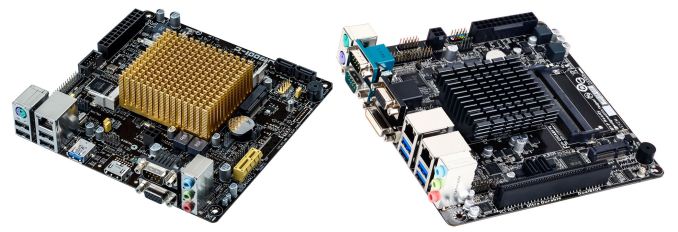
All the recent talk of Haswell-E and high-end refreshes has obscured the more casual computing market. The Bay Trail platform uses Intel’s Atom based Silvermont cores and competes directly against AMD’s Kabini for integrated computing, digital signage and cheap computing models. Today we compare two mini-ITX Celeron J1900 based motherboards: the GIGABYTE J1900N-D3V at $85 and the ASUS J1900I-C at $92, as well as the SoC itself.
Bay Trail-D Overview
Intel’s Atom Silvermont based architecture covers four SoC areas:
- Smartphones, in the form of Merrifield and Moorefield
- Tablets, Notebooks and Embedded in the form of Bay Trail
- Microservers and Storage in the form of Avoton
- Network and Communications in the form of Rangeley
We tested the C2750 eight-core Avoton SoC in the ASRock C2750D4I, a system oriented around maximum DRAM and storage in a mini-ITX form factor, and reported on GIGABYTE’s 46x C2750 Avoton server back at Computex 2014. The microserver market is apparently ripe for Avoton, but Bay Trail makes the desktop and tablet spaces a little more confusing.
Bay Trail comes in four forms:
- Bay Trail-D, for Desktop Systems at 6W to 20W
- Bay Trail-I, for Embedded and Automotive at 5W to 10W
- Bay Trail-M, for Mobile and Netbooks at 4W to 7.5W
- Bay Trail-T, for Tablets and Hybrids at 2W
We have covered Bay Trail in Mobile and Tablets, such as the ASUS Transformer Book T100 that has the Atom Z3740 Bay Trail-T, but the casual desktop space is still an interesting market. ECS’ LIVA is a perfect example of this: Ganesh’s review of the LIVA with the 4.5W Celeron N2806 Bay Trail-M shows that with enough innovation, some interesting designs can be produced.
Today’s review focuses on the Celeron J1900, a quad core 10W Bay Trail-D with Intel Ivy Bridge HD Graphics (6 EUs). The CPU has a base frequency of 2.0 GHz with a 2.42 GHz Turbo mode, 2 MB of L2 cache and support for dual channel DDR3L-1333. The J1900 was one of the targets of AMD’s AM1 Kabini launch earlier in the year, where the two traded blows on functionality:
| AMD Athlon 5350 vs. Intel Celeron J1900 | ||||
| Athlon 5350 | Celeron J1900 | |||
| CPU Architecture | Jaguar | Silvermont | ||
| CPU Cores | 4 | 4 | ||
| CPU Frequency | 2.05 GHz | 2.0 GHz / 2.4 GHz Turbo | ||
| GPU Cores | 128 SPs | 6 EUs | ||
| GPU Frequency | 600 MHz | 688 MHz | ||
| Memory Channels | Single | Dual | ||
| Memory Frequency | 1600 MHz | 1333 MHz | ||
| L2 Cache | 2 MB | 2 MB | ||
| TDP | 25 W | 10 W | ||
| Price | $59 | $82 | ||
AMD’s main power point for Kabini was the upgradable platform, due to Intel’s Bay Trail involving soldered on CPUs. Memory compatibility is traded, with Intel supporting dual channel but at a lower frequency. Price is also a battleground, along with GPU cores, although Intel uses significantly less power (on paper).
Because Bay Trail-D is a BGA processor, this means that the processor and motherboard must be purchased in tandem. There are a number of Bay Trail-D combinations available for purchase:
$200 – Jetway JNF9M-2930 (Celeron N2930, Bay Trail-M)
$150 – Habey MITX-6771 (Celeron J1900, Bay Trail-D)
$118 – ASRock Q1900TM-ITX (J1900)
$99 – ASRock Q1900DC-ITX (J1900)
$85 – GIGABYTE J1900N-D3V (J1900)
$80 – ASUS J1800I-A (Celeron J1800, Bay Trail-D)
$79 – ASUS J1800I-C (J1800)
$76 – ASRock Q1900-ITX (J1900)
$75 – Foxconn D190S (J1900)
$70 – ASRock Q1900M (J1900)
$70 – ASRock Q1900B-ITX (J1900)
$63 – Biostar J1800NP (J1800)
$60 – ASRock D1800M (J1800)
$60 – ASRock D1800B-ITX (J1800)
$60 – ASUS J1800I-C (J1800)
Thus for this review, we chose two of what might be the most popular Bay Trail-D motherboards for home builds: two mini-ITX systems, the GIGABYTE J1900N-D3V and the ASUS J1900I-C. Both of these use the Celeron J1900 processor, whereby the J1900 sits in the middle of Intel’s Bay Trail-D offerings but is the top SKU with the Celeron nomenclature:
| Bay Trail-D Comparison | |||||||
| Cores | CPU Frequency |
TDP | L2 Cache | IGP | IGP Frequency |
Price | |
| Celeron J1750 | 2 | 2410 | 10W | 1 MB | HD (Ivy) | 688 / 750 | |
| Celeron J1800 | 2 | 2410 / 2580 | 10W | 1 MB | HD (Ivy) | 688 / 792 | $72 |
| Celeron J1850 | 4 | 2000 | 10W | 2 MB | HD (Ivy) | 688 / 792 | |
| Celeron J1900 | 4 | 2000 / 2420 | 10W | 2 MB | HD (Ivy) | 688 / 854 | $82 |
| Pentium J2850 | 4 | 2410 | 10W | 2 MB | HD (Ivy) | 688 / 792 | |
| Pentium J2900 | 4 | 2410 / 2670 | 10W | 2 MB | HD (Ivy) | 688 / 896 | $94 |
| C2550 (Avoton) | 4 | 2400 / 2600 | 14W | 2 MB | None | N/A | $86 |
| C2750 (Avoton) | 8 | 2400 / 2600 | 20W | 4 MB | None | N/A | $171 |
Four Silvermont cores at 2 GHz for 10W sounds impressive, especially when I think back a decade to what I had back at university, or the 35W Core 2 Mobile CPU I had in my last laptop. As we found with the C2750, single thread speed should be reasonable and while multithreaded applications can take advantage, it doesn’t replace an i3, but ultimately that is not the intended market. Both the GIGABYTE J1900N-D3V and ASUS J1900I-C are going for that base desktop market, where ‘some memory’ and ‘some storage’ are needed, such as digital signage, a basic HTPC or run-of-the-mill all-access government machines.
It is worth noting that for Bay-Trail D, there are two steppings of the processors:
The new C0 stepping allows Intel Quick Sync to be used, but aside from the change in stepping (B3 to C0) there is no other outward indication which version is going to be used unless you are a customer that deals with Intel directly. Even though our samples in this review were new, both contained the B3 stepping version of the SoC.
Nevertheless, some of the Bay Trail-D SKUs to come with a form of Intel Burst, allowing parts of the SoC to turbo depending on how power is needed:
The Bay Trail Chipset
Similar with AM1, the integration of the IO into the SoC means there is no formal south bridge to distribute the ports and all routing is via the SoC:
Here the System Agent negotiates data between the dual channel DDR3L memory controllers, the Silvermont dual core ‘modules’ and the graphics, supplied as 6 EUs based on the Ivy Bridge video architecture. Because the Bay Trail SoC supports far fewer I/O connections compared to our usual foray into consumer based motherboard/CPU combinations, a mini-ITX is enough to almost fit them all.
The full block diagram for the J1900N-D3V is:
The SoC allows four PCIe 2.0 lanes from the chipset, which the manufacturer can use network connections or other IO controllers for. Here GIGABYTE has used two for Realtek NICs, one for a PCIe to PCI bridge and a mini-PCIe for a WiFi card or similar. The SoC supports two SATA 3 Gbps and a single USB 3.0 port, with this GIGABYTE motherbaord using a Renesas hub on that USB 3.0 to expand the offering to four.
Here is where Bay Trail comes across an issue. The system is designed to be cheap and competing with Kabini, meaning that motherboard manufacturers cannot fill the product up with controllers that cost a lot. It would be interesting if the PCIe lanes were used for additional SATA controllers, allowing for a large storage system, but that ends up being exactly what the C2750D4I is. Also, the decision here on the GIGABYTE to use a PCI slot will be for legacy use, as the latest graphics card available that uses PCI would be a HD 5450 or GT610/430.
Legacy connectors are always a touchy subject. Some motherboard reviews on products with a PS/2 or PCI slot might end up with a comment wondering why they still exist. The answer lies in industry, because upgrading that $1,000 PC is cheaper than upgrading the $5,000,000 bit of 15-year old equipment it is connected to. Bay Trail-D, even though is offered to the public, has a use in these motherboards for industry, so GIGABYTE and ASUS have to cover the bases. There are a few key points to consider in this respect:
- Does it have the right connectors?
- Does it cost a lot?
- Is it easy to set up?
- Is it responsive enough?
- Will it compute as much as is needed in a reasonable time?
The last two points end up being the usual reason for upgrading. For example, back in the lab I worked in several years ago our vintage equipment (an older version of this) ran on Pentium 4 machines but required a legacy slot for the proprietary communication and control card it ran on. In order to upgrade, it had to meet the above criteria. This is why legacy still exists.
Back to the review: we are putting both the GIGABYTE J1900N-D3V and the ASUS J1900I-C through their paces for usability as well as the J1900 SoC for responsiveness. These boards are in the $85-$95 mark, providing a competitive price point against AMD’s Kabini. Motherboards at the cheaper end of the spectrum tend to be worked on by less people, purely because the profit margins are low. Both the motherboards in this review are dealing with the fact that they have to include the SoC on the motherboard at the point of sale. Intel lists the price of the J1900 as $82, meaning that these SoCs are actually sold at a discount or in a discounted-revenue strategy, or the motherboard manufacturers are getting them severely discounted in order to make cents per sale.


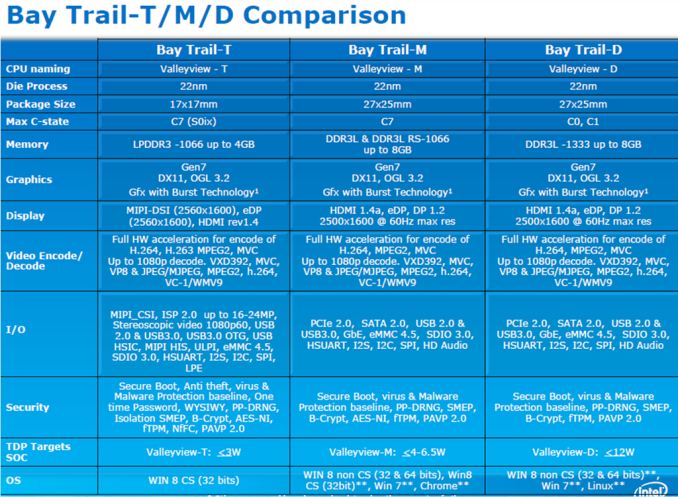
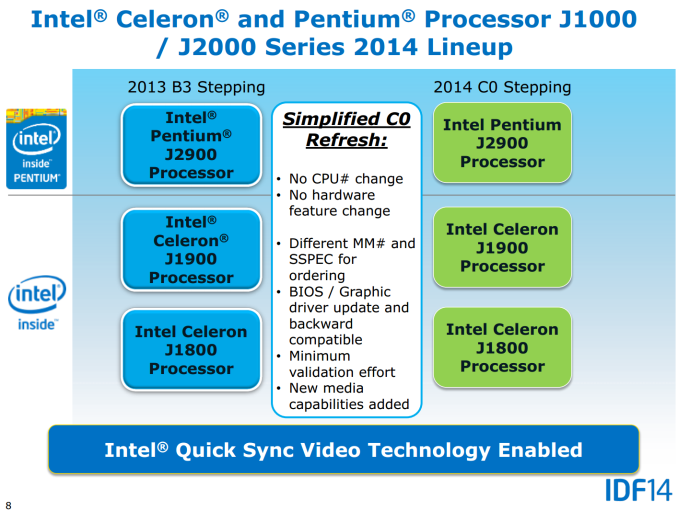
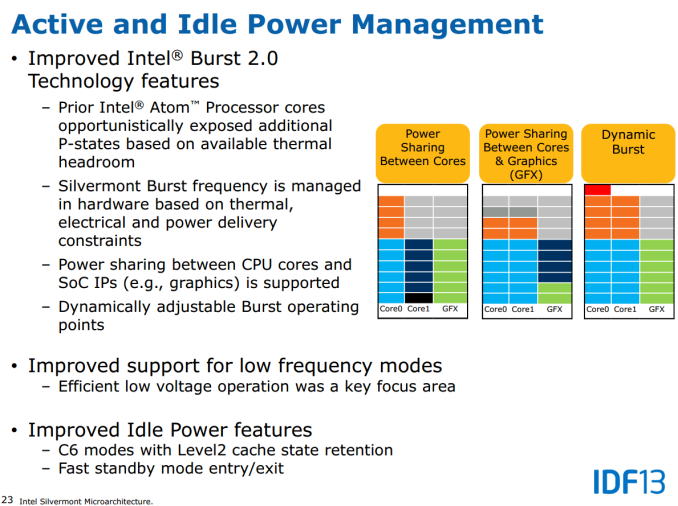
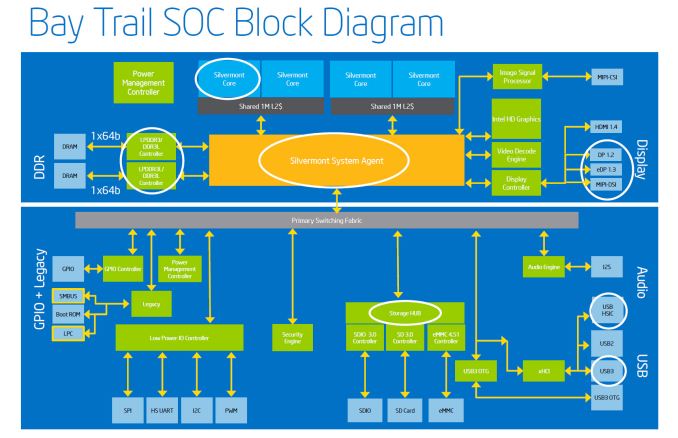
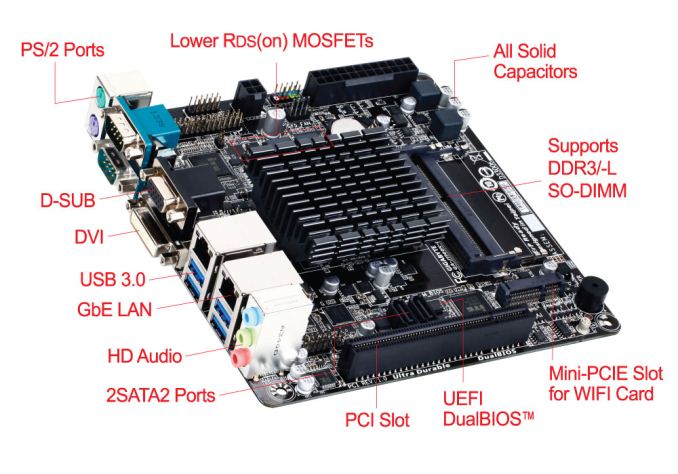
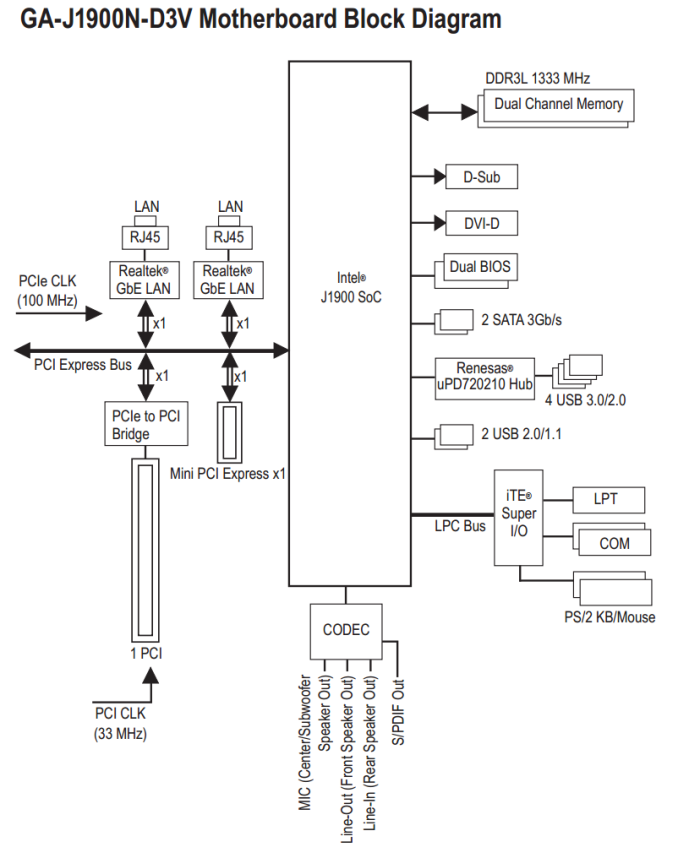








60 Comments
View All Comments
KWIE - Monday, October 20, 2014 - link
I actually love this little platform - I went for the ASRock Q1900-ITX as I needed four SATA headers to use it as the base for a FreeNAS box with Plex installed in a jail (FreeNAS booting from USB and 4-drive mirrored/striped with ZFS). It works absolutely wonderfully and the only thing I can hear is the drives. For around 200 euros I was able to buy this, BitFenix Prodigy case, 8GB RAM etc. etc. etc. and I was able to move the drives out of my main rig which now doesn't have to be on 24/7, saving more than the thing is worth a year in power (my main rig idles at around 100W - this idles at 14W. Going on a 24/7 calculation and with prices in Germany (25c per KWh) this means I'm saving around 184 a year). Can't complain in the slightest.llisandro - Monday, October 20, 2014 - link
Ian, I was really hoping to see Anandtech's usual "Decoding and Rendering Benchmarks" on these guys, bummer. I would assume people care more about HTPC-centric benchmarks than raw CPU power on these kinds of systems.friikazoid - Monday, October 20, 2014 - link
I have a question for those of you, who have experience building with these(/similar) boards.Would any of you be willing to post your complete builds with these? As in the case, memory, drives you chose? I've been building standard desktops for years, but would really like to try a small experiment with one of these. I'll be honest though, I don't have as much time on my hands now as I used to to do some research. So if anyone has suggestions on how to put a small cheap system together with these, I would appreciate it?
For example, do you guys go for HTPC/mini-ITX type cases? Typical PSU or use extrenal brick? Any cases work better than others? Have any fun tricks with hardware, etc. to make things work?
I was thinking something like this could be really fun with an immersion liquid cooled system. Not for performance obviously, just for the effect, haha.
abufrejoval - Tuesday, October 21, 2014 - link
I used a M350 Universal Mini-ITX enclosure and an 80Watt Pico PSU, because that was the first one to include the required 12V connector. External brick is a 60Watt type. Both the Pico PSU and the brick are overspec'd but there is nothing lower available. For this board idle power is 10Watts the dual Core variant with a little less hardware did 6.3 Watts so the Pico PSU/Brick combination doesn't seem too bad. Certainly an onboard PSU with an 19V supply would be more elegant.I used 2 4GB Kingston Value RAM DIMMs, which need to be 1.35V low power.
For storage I took an older C300 256GB from Crucial that was lying around, because the major aim was a silent desktop.
The system is 100% silent and sufficiently fast enough for all desktop like activities. I've tried Windows 7 and 8, CentOS 6+7, Fedora 20 and Android x86 with good success and support.
It's so uncomplicated and stable it's downright boring.
schizoide - Monday, October 20, 2014 - link
Asus and HP Chromeboxes are regularly available for ~$135. They have Haswell celeron CPUs, which are much, much faster than these atoms. For that price you also get a case, 2GB RAM, a 16GB M2 SSD, and wifi. Oh, and it has a HDMI port. Out of the box they make amazing HTPCs-- install openELEC and you're good to go with XBMC or Plex.Everything is fully upgradable, if you want to replace the RAM and SSD you can do so. They work 100% fine in linux and can run windows too, although you do need USB audio for that as no drivers work. The chromeboxes aren't fanless, but they are very, very quiet.
Given that the chromeboxes exist at that price point, I can't figure out what consumer need these atoms really fill.
Shiitaki - Monday, October 20, 2014 - link
I happen to be using an quad core Atom for my HTPC, but only to get the Nvidia GPU that is part of the motherboard.In any other scenario it is better to buy the least expensive motherboard and desktop processor. For 20 or 30 bucks more you get far better performance, better connectivity, etc. The ITX is a great idea, but the premium on the parts, and practical considerations like connecting hard disks make it less useful than it would seem.
If I am building a NAS, then I should use a motherboard with 6 SATA and a power supply with enough connectors. If I'm building a media center pc, software decode is still the best, most comapatible, and future proof. And that will take something better than an Atom.
Between Intel holding the Atom back at the beginning, and the aggressive pricing of the core cpus, the Atom is hard to justify since the cost savings is so small when you consider the cost of the entire machine.
LoneWolf15 - Tuesday, October 21, 2014 - link
Excellent article. This makes it clear that I wouldn't replace my Core i3-3225 in my home theater PC, but the Gigabyte board with its dual NICs would make an incredible platform for Sophos free home firewall appliance with UTM.http://www.sophos.com/en-us/products/free-tools/so...
It's limited to fifty IPs (fine for home) but something like this gives you a big boy's toy for experimenting with LAN configurations, using your home as a lab.
abufrejoval - Tuesday, October 21, 2014 - link
Some additional data you may find useful:The nominal clock rates seem to be for marketing purposes mostly and might have been hard limits in the previous generation (J1850 and J1750): I've never seen them in practice.
The J1900 and J1800 parts are officially listed as 2.41 or 2.58 Turbo frequencies, but contrary to Haswell U-type CPUs they hit and sustain that speed constantly under load and they drop to 1.3GHz on idle.
Same with the GPU speeds, which will sustain the maximum specified speeds as J1900/J1800 parts.
I've run Prime95 for hours on the J1900 without it ever dropping below 2.41 GHz. When I add FurMark for the GPU, it will start lowering down, once it reaches the throttling temperature configured in the BIOS (or the internal hard limit). That combination reached 28 Watts behind the PSUs (Pico-ATX & external 12V brick), while idle for was around 10 Watts for the GA-J1900N-D3V and 6.3 Watts for a GA-J1800N-D2H (maximum power there was 22 Watts).
The J1800 couldn't be pushed to throttle nor any higher than 60°C with any combination of Prime95 and Furmark nor wourld it ever use any frequency below the "Turbo" setting.
The J1900 reached the 80°C throttle I had configured in the BIOS after hours of running Prime95 and Furmark in combination inside a M350 Universal Mini-ITX enclosure by Mini-Box Black.
No CPU or Graphics benchmark alone will ever get there, you'd need both so I'm confident it never throttles during normal use. Using the exact same passive cooler on both devices may not be optimal, but the 10 Watt TDP figure on both J1900 and J1800 is simply misleading: The two devices never use the same power under load or idle.
At 2.41 GHz the J1900 reached about 80% of the speed of a Core2 based QX9100 at 2.4 GHz using 18 Watts instead of 58 Watts on POVray and CineBench 15 CPU (no GPU) loads: The IPC is pretty impressive and these are full CPU cores, not hyperthreads or partial clusters sharing FPUs or decoders.
The DVI connector carries full audio signals and with an DVI to HDMI dongle you have full HDMI functionality including HDCP. 1980x1200 resolution works with DVI and VGA, but might not with HDMI.
I found it hard to gauge, where the almost 4 Watts of idle power difference between the two Gigabyte boards came from (10 vs. 6.3).
CPU-Z always reported similar power figures for the quad J1900 and the dual J1800 under load and idle, while the power meter behind the PSU showed twice the increase when the quad CPU was loaded vs. the dual.
It leads me to believe that CPU-Z measures power figures only on one of the two J1900 dual clusters: No idea wether this is a software bug or and LPC bug.
Apart from dual vs. quad CPU the J1900 hold the Renesas USB hub chip and the extra Ethernet port. Deactivating the second Ethernet port (or in fact both) mode no difference whatsoever on idle power which leaves either the USB hub itself or simply signals that the 2nd CPU complex doesn't shut down completely, while the system is idle.
This review could have provided a clue with some careful idle power comparison between these boards: An opportunity missed!
If the extra CPU complex is the culprit (hard to imagine, actually) a J1800 might be the better choice for desktop work, where the two extra cores of a J1900 won't find anything useful to do.
I can't see too many people using a J1900 doing Linux kernel compiles or even Android builds, but there the two extra cores might actually be useful.
I wanted a completely silent system first of all and worried somewhat less about the last Watt of idle power consumption. One use case other than (or in addition to) silent desktop would be a firewall, home server and SIP telephony appliance and in that case the extra CPU cores allow for a little more headroom.
As would an extra 8GB of DRAM, which is not supposed to work according to Intel, but simply does if you buy an ASRock branded J1900, which simply support 16GB!
Most likely it's an Intel market segmentation limitation and not a technical obstacle, but your BIOS most likely needs to support it, too.
artk2219 - Friday, October 24, 2014 - link
I just wanted to post this here. Dualcore sandy bridge cpu, m-itx, m-pcie, it can run a laptop display, msata, runs off a 19v powersupply from a dell or hp, and uses sodimms in case you have any laptop memory around. For 52 dollars.http://www.newegg.com/Product/Product.aspx?Item=N8...
GlauberReis - Sunday, November 20, 2016 - link
Does it j1900 it's good to development java, javascript, frameworks and database ?